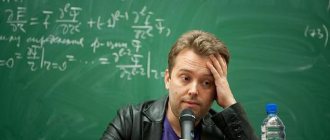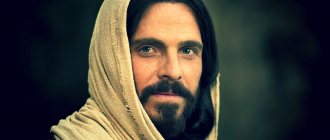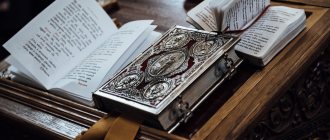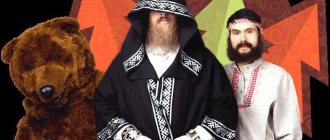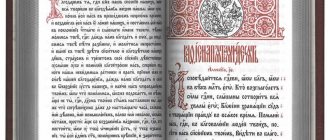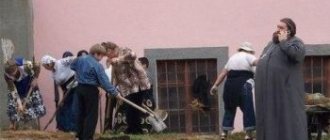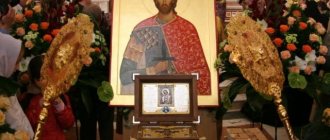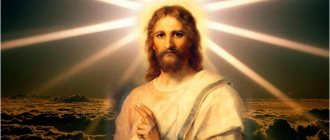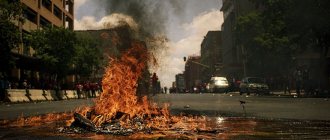Bible Questions and Answers
Published 05.11.2011
Why in the Gospel of John Jesus Christ drove the merchants (money changers) out of the temple. How did these activities begin in the temple? It looks like they did not come to us from the pages of the Old Testament.
In which temple did all this happen?
This episode is not at all about the kind of structure that we usually imagine today when we hear the word “temple” or “church.” In essence, the Jerusalem Temple was a city within a city, with many buildings and courtyards.
It was a grandiose structure, one of the wonders of the world, which became especially magnificent after it was rebuilt and expanded many times by the Jewish king Herod the Great (this work was more or less completed just in time for the Nativity of Jesus Christ). Not only the temple building itself, which was enlarged and lined with white stone, gold and silver, underwent reconstruction; The space around him also changed. High walls were erected around the temple, inside which service premises were located; On the inside, galleries were added to them, in which liturgical utensils were sold.
Entrance to the Temple Mount in ancient Jerusalem
And outside, behind the southern wall, there was a so-called courtyard - a huge stone-paved area with fountains. Here - unlike the territory outside the walls and, of course, from the temple building itself - access was open to everyone, even pagans. So over time this court began to be called “the court of the pagans.”
It was intended mainly for the trade in sacrificial animals.
Ministry of the Lord Jesus Christ from the first Easter to the second
John: 4
4 Now He had to pass through Samaria. 5 So He comes to a city of Samaria, called Sychar, near the plot of land that Jacob gave to his son Joseph. 6 There was Jacob's well. Jesus, weary from the journey, sat down by the well. It was about six o'clock. 7 A woman comes from Samaria to draw water. Jesus says to her: Give me something to drink. 8 For his disciples went into the city to buy food. 9 The Samaritan woman said to Him, “How can you, being a Jew, ask me, a Samaritan woman, for a drink? for Jews do not communicate with Samaritans. 10 Jesus answered and said to her, “If you knew the gift of God and who it is that says to you, Give Me a drink, then you yourself would have asked Him, and He would have given you living water.” 11 The woman said to Him: Master! you have nothing to draw with, but the well is deep; Where did you get your living water from? 12 Are you greater than our father Jacob, who gave us this well and drank from it, and his children and his cattle? 13 Jesus answered and said to her, “Everyone who drinks this water will thirst again; 14 but whoever drinks of the water that I will give him will never thirst; but the water that I will give him will become in him a fountain of water springing up into eternal life. 15 The woman said to Him: Master! give me this water so that I won’t be thirsty and won’t have to come here to draw. 16 Jesus said to her, “Go, call your husband and come here.” 17 The woman answered, “I have no husband.” Jesus says to her, “You are right when you say that you have no husband, 18 for you have had five husbands, and the one you now have is not your husband; That's right what you said. 19 The woman said to Him: Lord! I see that you are a prophet. 20 Our fathers worshiped on this mountain, but you say that the place where we should worship is in Jerusalem. 21 Jesus said to her, Believe Me, that the time is coming when you will worship the Father, neither on this mountain nor in Jerusalem. 22 You do not know what you worship, but we know what we worship, for salvation comes from the Jews. 23 But the time will come, and has already come, when the true worshipers will worship the Father in spirit and truth, for the Father is seeking such worshipers for Himself. 24 God is spirit, and those who worship him must worship in spirit and in truth. 25 The woman said to Him: I know that the Messiah will come, that is, Christ; when He comes, He will tell us everything. 26 Jesus said to her, “It is I who speak to you.” 27 At this time His disciples came and were surprised that He was talking to the woman; however, not one said: what do you require? or: what are you talking to her about? 28 Then the woman left her waterpot and went into the city, and said to the people: 29 Come, see a man, who told me all things that I have done: is not this the Christ? 30 They left the city and went to Him. 31 Meanwhile the disciples asked Him, saying: Rabbi! eat. 32 But He said to them, “I have food that you do not know.” 33 Therefore the disciples said to one another, “Who brought Him anything to eat?” 34 Jesus saith unto them, My food is to do the will of Him that sent Me, and to finish His work. 35 Do you not say that there are still four months and the harvest will come? But I say to you: lift up your eyes and look at the fields, how they are white and ripe for harvest. 36 He who reaps receives his reward and reaps fruit for eternal life, so that both he who sows and he who reaps will rejoice together, 37 for in this case the saying is true: one sows, and another reaps. 38 I sent you to reap that for which you did not labor: others labored, but you entered into their labor. 39 And many Samaritans from that city believed in Him because of the word of the woman, who testified that He told her all that she had done. 40 And therefore, when the Samaritans came to Him, they asked Him to stay with them; and He stayed there two days. 41 And an even greater number believed at His word. 42 And they said to the woman, “It is no longer because of your words that we believe, for we ourselves have heard and known that He is truly the Savior of the world, Christ.”
What other sacrificial animals are they?
The making of sacrifices was, in fact, the main part of the worship in the Jerusalem Temple. If a Jew committed a sin or wanted to thank God for some good deed, then, according to the Old Testament law, he had to sacrifice to Him a lamb, a kid, an ox, or, as a last resort (if the person was poor), a dove. The most important thing is that the individual was required to be male and without any flaw or defect: the best was sacrificed to God, and not what was necessary.
The animal or bird was given to the priest, who examined it to make sure it was suitable for the sacrifice, and then slaughtered it and burned it on the temple altar, in whole or in part. After the ritual was performed, the sin was considered atoned for and gratitude accepted. After all, a person worked hard, parted with something valuable (and livestock was very highly valued in those days) in order to maintain or restore a relationship of mutual trust with God.
It is quite obvious that the event that the evangelists, and in particular John, talk about, did not happen inside the temple building, or especially the Holy of Holies of the temple (no one except the priests dared to enter there under pain of death), but outside - in that very “court of the pagans” " This courtyard was part of the temple complex and was also called part of the temple, but only in an expanded sense. It was quite normal that they sold sacrificial animals there. It is clear that this was not what caused the wrath of Jesus Christ.
What then outraged Christ, if not the very fact of trade in the temple?
On major Jewish holidays, such as Passover, thousands of visitors flocked to Jerusalem. First of all, these were Jews who in normal times lived in dispersion, far from Jerusalem - in Rome, Egypt, Greece, Cyprus, etc. They did not have the opportunity to bring sacrificial animals with them, so they bought them on the spot, in Jerusalem.
The temple aristocracy, led by the high priest, took advantage of this to turn the temple trade in sacrificial animals into a highly profitable business.
Here it must be recalled that by the time of the Nativity of Christ, Judea had actually lost state independence and was one of the outlying provinces of the Roman Empire. A Roman garrison was stationed in Jerusalem, the Jews were obliged to pay a tax to the Roman emperor (it was collected by the “compromisers” despised by the Jewish patriots - tax collectors), and, of course, here, as elsewhere in the empire, Roman coins - denarii - were in circulation.
Denarius of Tiberius
There was one problem with these denarii: they depicted the profile of the Roman emperor, Caesar. We remember this well from the Gospel: when Christ was once asked whether to pay taxes to Caesar or not, He responded by asking to be reminded whose image was on the denarii. When they answered Him, “Caesar’s things,” He said, “Render therefore the things that are Caesar’s to Caesar, and the things that are God’s to God” (Matt. 22:21).
The Mosaic Law strictly prohibited the worship of images, and on this basis the high priests prohibited the use of Roman denarii in the temple. For trade operations on the temple territory, they introduced a special temple currency - sacred shekels *, the same ones with which the Jews paid temple taxes.
* The shekel (or modern shekel) in ancient times was a measure of the weight of precious metals - silver and gold, borrowed by the Jews from the Phoenicians. During Christ's earthly life, a shekel of silver, weighing just over 11 grams, was the standard unit of currency. – Approx. ed.)
Remember how in the Gospel of Matthew, the collectors of this tax call on the Apostle Peter to fulfill his religious duty and contribute the required two didrachmas* to the temple treasury - for himself and for the Teacher?
* Didrachma - a Roman silver coin in denomination of two drachmas, was equal to a half-shekel and was accepted as payment of temple tax for one person. – Approx. ed.
And how did Christ, having learned about this, order Peter to catch a fish, take a coin from its mouth - a statir * - and give it for both of them? (Mt. 17:24–27).
*Statir , or tetradrachm - a coin of four drachmas, was equal to one sacred shekel. – Approx. ed.
So, the high priests established a rule: all trade transactions on the temple territory are carried out exclusively in temple currency. And they organized the exchange of denarii (as well as other money) for this special currency - in that very “court of the pagans”. This same temple money - and only this - was used when the priests inspected the purchased animals. And these foreign exchange transactions were carried out with a commission that amounted to almost two-thirds of the exchange amount! This order was extremely beneficial to the temple aristocracy. It was in her hands that all the profits from the exchange of money and from subsequent financial transactions with gold ended up.
Another abuse associated with the functioning of the temple currency was written already in the 4th–5th centuries by the creator of the Latin translation of the Bible, Saint Jerome of Stridon, who traveled for many years in the Holy Land and became well acquainted with the former customs of the Jews. Since many of those who wanted to bring sacrificial gifts themselves needed money, the high priests allowed the money changers to lend money to those in need on guarantee , says Saint Jerome. At the same time, however, it was necessary to circumvent the legal requirement that prohibited giving money to the Jews in interest (that is, taking interest for using a loan). As a result, the priests came up with another way to make money on loans: they introduced into the custom “small cheap gifts [gifts], for example: roasted peas, raisins and apples of various kinds.” That is, people who took loans from money changers gave them gifts for this - a kind of bribe .
This was something that the Lord warned His people against many times through the mouth of many prophets. Even in the time of Moses, the Israelites were told quite clearly: Do not pervert the law, do not look at faces, and do not take gifts, for gifts blind the eyes of the wise and pervert the work of the righteous (Deut. 16:19 ). And all this flourished now, and not just anywhere, but in the immediate vicinity of the temple!
This is what Christ was outraged about: people turned His Father’s house, a house of prayer, into a business enterprise! It was no longer a question of trade at the temple, which would help pilgrims coming from afar to buy a sacrificial animal on the spot - the temple itself was turning into a kind of “annex” to a dubious business office.
The main guide to spiritual life for the Jews has always remained the very first of the Ten Commandments: I am the Lord thy God... thou shalt have no other gods before Me (Exodus 20 :2). The Savior’s anger was caused by the fact that the high priests turned out to be, according to the word of the prophet Ezekiel, shepherds who feed themselves (cf. Ezekiel 34 :8), creating difficulties for everyone else who wanted to serve God. Called priests, they turned out to be essentially idolaters, like those Israelites who once cast themselves a golden calf and began to worship it.
This is precisely what explains the decisive actions of Christ described by the evangelists.
Expulsion of traders from the Temple
“Expulsion of traders from the Temple”, 14th century fresco. at the Church of the Assumption of the Virgin Mary in Gracanica, Serbia, Kosovo.
The day after the solemn Entry into Jerusalem, Christ performs an action called “Expelling the merchants from the Temple.” For some reason, we pay little attention to this action of Christ, which without exaggeration can be called another miracle.
“And Jesus entered into the temple of God and drove out all those who were selling and buying in the temple, and overturned the tables of the money changers and the seats of those who sold doves, and said to them: It is written, “My house will be called a house of prayer; and you made it a den of robbers.”
(Matt. 21:12-13)
In general, about this episode, I have long been tormented by the thought: not everything here is as simple as it seems at first glance, some kind of secret is hidden here. Why wasn't Jesus captured right away? - after all, there was such a wonderful occasion: here He first declared Himself the Son of God, calling the Temple “The House of My Father.” And it was precisely these words, perceived by the leaders of the people of Israel as sacrilege, that served as the reason for the death sentence.
What actually happened that day in Jerusalem?
Wikipedia gives this explanation:
“The event described is an episode of the earthly life of Jesus Christ. On the Passover holiday in Jerusalem, Jews were obliged to slaughter the Passover lambs and make sacrifices to God, and therefore they drove sacrificial cattle into the temple and set up shops to sell everything necessary for the sacrifices. Change offices were also located here: Roman coins were in use, and taxes to the temple were legally paid in Jewish shekels. In addition, items not related to the sacrifice were also traded in the temple courtyard, turning it into a market square.”
One more clarification needs to be made here: there were several courtyards at the Temple. Already at the Solomon Temple there were several courtyards, and sacrifices were performed precisely on the altar built in the courtyard. Herod further expanded the site on Mount Moriah, strengthening the slopes of the mountain with stone masonry so that it became a real fortress, and the Romans in 70 had a lot of difficulty taking it - along with the last defenders of Jerusalem. Thus, people prayed in courtyards, in the open air, and only priests were allowed to enter the very building of the Temple - into the Holy Place, in the depths of which the Holy of Holies was hidden behind the curtain, where the high priest entered for prayer and incense once a year on the Feast of Atonement ( Yom Kippur is celebrated in October). Burnt offerings continued to be performed in the courtyard of Herod's new temple. And only in the territory of these courtyards could Jesus preach and talk with the people, and after His death and resurrection, the apostles.
One of the options for reconstructing the plan of Herod's Temple.
But let's look at the plan of Solomon's Temple (the principle of planning during the construction of Herod's Temple was preserved):
Let's pay attention to the marks: in the middle on the left - “Israelites”, on the right - “Court of the People”. What is the difference between “the people” and “Israelites”? The fact that “the people” meant “another” people - those who were not Israelis were called “goyim,” and for them, it turns out, Solomon provided a separate place for prayers. Not for everyone, of course, but for those people from other nations who revered the God of Israel.
There was such a courtyard for the “goyim” or pagan worshipers of the One God at Herod’s Temple. This is where traders and money changers occupied it, thereby preventing the “pagans” from praying to the One God. (Remember that the Jerusalem Temple was the only place where Old Testament worship was performed; what is called a “synagogue” is simply a place for meeting, reading Scripture and general prayers, but not for offering sacrifice, which since the destruction of the Temple is no longer offered).
Mark in his Gospel (11:17) quotes the words of Christ more fully:
“And he taught them, saying, Is it not written, My house shall be called a house of prayer for all nations ? and you made it a den of robbers.”
Priest Alexander Usatov (Orthodox forum “Good Conversation” https://psgp.ru/forum/index.php?topic=186.0) explains:
“The indicated event took place in the so-called court of the pagans, this is the outer circle in relation to the Temple building (only priests could enter the Temple itself).
Pagans who worshiped the God of Israel could pray here.
This is how Solomon prayed about this at the dedication of the Temple:
“If a stranger, who is not of Your people Israel, comes from a far land for the sake of Your name—for they too will hear of Your great name and of Your mighty hand and of Your outstretched arm—and he will come and pray at this temple, Hear from heaven, from Your dwelling place, and do everything that a foreigner will cry to You for, so that all the nations of the earth will know Your name, so that they will fear You, like Your people Israel, so that they will know that this temple which I am built" (1 Kings 8:41-43).
But in reality, this place of pagan prayer was occupied by money changers and merchants who helped pilgrims exchange pagan money for sacred shekels, as well as purchase a sacrificial animal.
The motives of everyone (selling and buying) were wonderful. Only they forgot about the pagans. We solved our problems at their expense.
And it was in defense of the calm prayer of foreigners at this holy place that Christ spoke. <�…>
The building of the temple in the Greek text of the Gospel is rendered by the word NAON, and the entire temple complex is IERON. Therefore, the original text puts everything in its place. It’s a pity that in the Russian translation the word TEMPLE is everywhere ».
So, instead of rejoicing that people from other nations began to worship the One God (as they believed, only the God of Israel, and other nations, therefore, have other “gods”), they decided, even despite the undoubted damage from this their mercantile interests, to oust them from the court specially intended for them, as if “forgetting” the words of the wise and revered King Solomon and establishing a monopoly on God. They force out true admirers and actually serve the “golden calf”!
The lowing of oxen, the bleating of sheep, the talking of people, disputes about prices, the clinking of coins - all this made the temple more like a bazaar than the house of God.
And it stinks! And the excrement of irrational animals! And the flies! And streams of blood in the courtyard nearby, where the cattle were slaughtered and laid on the altar! And the smoke and smell of burnt meat from the neighboring yard!
And Christ, it turns out, makes room for other peoples at the temple, clearing the courtyard, just as Hercules once cleared the Augean stables of dung!
But that is not all.
Further Wikipedia:
“After His entry into Jerusalem, Christ went straight to the temple, saw the merchants and drove them out: And Jesus entered into the temple of God and drove out all those who were selling and buying in the temple, and overturned the tables of the money changers and the seats of those who sold doves, and said to them: It is written, “My house” it will be called a house of prayer; and you made it a den of robbers. (Matt. 21:12-13).
We see a more detailed narrative and some important details in the Evangelist John: The Passover of the Jews was approaching, and Jesus came to Jerusalem and found that oxen, sheep and doves were being sold in the temple, and money changers were sitting. And, making a scourge of ropes, he drove everyone out of the temple, [also] the sheep and oxen; and he scattered the money from the money changers and overturned their tables. And he said to those who sold doves: Take this from here, and do not make My Father’s house a house of trade. (John 2:13-16).”
A den of robbers - in Church Slavonic it sounds like a kind of euphemism. In Russian it is called a “den of thieves” or simply “raspberry”. And all this is on the territory of the holy place - Hierona.
This episode is the only one in the Gospel where Jesus appears angry. What can cause the sacred wrath of the meek Son of God? Human greed. Even at the gates of the Temple of God, people are not ashamed to deceive buyers - their own co-religionists and half-bloods, since the “goyim” are no longer allowed in. And there is no need to say what percentage of money was exchanged on currency exchange operations. In addition, deception in the trade of sacred objects seems to be another category of sin - sacrilege. Moreover, all this was covered up with hypocritical arguments about the need to comply with religious instructions - the inadmissibility of buying sacrificial animals with money with images of the emperor and pagan gods. After all, why did the temple servants set up a currency exchange office in the yard? The point is not only that Jews from all over the Empire and even from other countries came to Jerusalem for the holidays and, accordingly, took with them the money that went there. But even in Israel itself, which was under Roman rule, Roman denarii were in circulation with the image of the profile of the emperor and the goddess Juno Coins.
The coins of Emperor Tiberius are denarii.
But the most valuable thing was the full-weight Tyrian shekels, the so-called silver coins (it was 30 Tyrian shekels - the “price of Blood” - that Judas would receive for betraying the Teacher), with the image of the Phoenician god Melqart (from Baal), and it was this money as the most solid and reliable currency went to the treasury of the Temple.
Tyrian shekel.
In addition, the Jews, even while under imperial rule, won the right to mint their own coins - shekels with their sacred images - with the stipulation that they were intended only for religious purposes. But the high priests who supervised the money changers profited to the fullest from the exchange rate. Truly, hypocrisy, reaching the point of cynicism.
Let me note in parentheses: I spent a very long time looking for a photograph of Jewish coins from the time of Roman rule. But she found only coins minted at a time when Israel was independent or relatively independent under Herod the Great. Perhaps there were enough of them in the hands of Pilate?
There are also coins issued during the 1st Jewish revolt (66-70 AD)
and even during the Bar Kokhba revolt (135). But there are no coins with sacred images of the required era. Did the high priests really set their money changers to exchange various coins, including the Roman denarius, for full-weight pieces of silver - Tyrian shekels? Then the justification for the need to exchange money for those where there are no images of people and gods is only a later pious explanation, even in some way a justification of the temple authorities, which is actually baseless.)
It is interesting that Jesus drove out the sellers of large animals with a whip and scattered the money of currency swindlers on the ground, but treated the sellers of pigeons very gently, simply asking them to leave. Let us remember that doves were bought and sacrificed by those who did not have money for a sheep, that is, poor people, although it was the high priests who bred them for sale, and, accordingly, their people sold them. Once upon a time, Christ Himself was redeemed as the firstborn (“the opener of lies”) with a pair of doves. Perhaps that is why He did not roughly drive them out, although after 33 years the prices for birds had skyrocketed and the poor were grumbling. And, driving out the merchants and money changers from the temple, Christ took aim, first of all, not so much at those merchants and money changers who were in the vestibule of the temple, but at the highest authority in Judea in the person of the high priests and their inner circle, because all the trading places around the Temple were controlled by them - everything was “seized.”
In general, it is difficult to imagine that one person could drive out a huge number of animals and people from the square. Yes, no one would have heard an ordinary person in the general hubbub, and if they had heard, they would have kicked him properly, and besides, there were temple guards there who had the authority to immediately, without talking, kill the troublemakers. But no one dared to disobey Jesus. Only the Son of God, by His divine power and authority, could do this.
And only the leaders of the temple, who were at that moment on the sidelines and, as if having nothing to do with it, holding back their rage, began to approach Him with questions: “What sign will you prove to us that you have the power to do this?” Apparently, numerous healings and even resurrections from the dead were not enough for them, including the one that Christ performed literally the day before - the resurrection of Lazarus of four days, i.e. a person who has already decomposed to the point where the flesh emits a characteristic odor and “the meat is separated from the bones.” They knew the prophecies that the Messiah would be recognized by healing and resurrecting, but they did not want to recognize the messianic dignity of Jesus of Nazareth.
To this Christ answered them: “Destroy this temple, and in three days I will raise it up.” But the Jews did not understand Him and said: “This temple took forty-six years to build, how can You raise it up in three days?”
These words were later recalled to him on the cross, laughing at him:
“Those who passed by cursed Him, nodding their heads and saying: Eh! destroying the temple, and building in three days! Save Yourself and come down from the cross” (Mark 15:29-30).
But the evangelist explains this answer of Jesus, although the apostles themselves understood them only in retrospect, when He was resurrected:
“By temple He meant His body, and with these words He predicted that when He was killed, He would rise again on the third day.” (John 2:21-22)
His human body is the Temple of God, the prototype of which was the tabernacle, lost by the Jews a long time ago, during the destruction of Jerusalem and the Babylonian captivity - the place of the presence of the Divine (in Hebrew - “Shekhina”; therefore the tabernacle is considered in Christianity to be one of the Old Testament prototypes of the Mother of God ). And this new Temple, the Church of the New Testament, in which dwells the Holy Spirit and the Body of Christ, distributed to the faithful in the Eucharist, now replaces the Temple of Jerusalem, which has fulfilled its purpose, desecrated and turned into a “den of thieves.” Just as the bloody Sacrifice of the Son of God henceforth replaces the burnt offerings in the courtyard of the Temple, and His disciples and followers until His Second Coming will offer the now bloodless Sacrifice.
The prophets already called for the abandonment of blood sacrifices.
“Did you bring Me sacrifices and grain gifts in the wilderness? I hate and reject your holidays. They are disgusting to me, your fat little bodies: I will not look at them” (Amos 5:21 et seq.).
“For I desire mercy rather than sacrifice, and knowledge of God rather than burnt offerings” (Hos. 6:6).
“Why do I need the multitude of your sacrifices? says the Lord. I am full of burnt offerings of rams and the fat of fattened cattle, and I do not want the blood of bulls and lambs and goats. ... Bear no more vain gifts: smoking is disgusting to Me; New moon and Saturdays, holiday gatherings I can’t stand: lawlessness - and celebration! My soul hates your new moons and your holidays: they are a burden to Me; It's hard for me to carry them. And when you stretch out your hands, I close My eyes from you; and when you multiply your prayers, I do not hear: your hands are full of blood. Wash yourself, make yourself clean; remove your evil deeds from before my eyes; stop doing evil; learn to do good, seek truth, save the oppressed, defend the orphan, stand up for the widow.”
(Isaiah 1:11-17).
Also in the text of Psalm 50 of repentance:
“For You do not desire sacrifice, I would give it; You do not favor burnt offerings; only the sacrifice of a broken heart is acceptable to You.”
(“As if you had wanted sacrifices, you would have given them: burnt offerings are not your pleasure. A sacrifice to God is a broken spirit: God will not despise a contrite and humble heart.”) But at the end of the psalm it still turns out that God is pleased with the laying of calves on the altar, because No one was going to abolish the sacred custom, and not only did no one listen to the prophets, they were simply killed (Matthew 21, 33 et seq.). Christ adds his fate to the fates of the beaten prophets.
Let us note that Christ casts out not only the dealers in sacrificial animals, i.e. not only those who sell, but also those who buy, i.e. those who were preparing for the holiday and wanted to buy a ram to bake and serve on the table on Easter night, thereby preventing the fulfillment of the sacred custom commanded by Moses himself. Eating the meat of the Passover lamb in the family circle was considered a sacrifice to God, and the fulfillment of this custom among the Jews was part of the concept of fulfilling the law. How can this fact be reconciled with what He Himself said: “Do not think that I came to destroy the law or the prophets: I did not come to destroy, but to fulfill” (Matthew 5:17). After all, by driving away those buying, He actually abolishes animal sacrifice.
Jesus was the only Man on earth who could fulfill God's Law, and He fulfilled it perfectly. Having voluntarily sacrificed Himself as a Great Sacrifice, Christ “rided the tiger”, turned evil into good, using the distortion of the Law of God to save fallen humanity, paradoxically inverting, turning the Fall and distortion of the Law into the restoration of the Law and through this - salvation from sin and its consequences .
How then can we understand Abraham's detailed instructions on how to perform the sacrifice? So understand that the Old Testament is the product of fallen man. The history of the constant falls of the “chosen people”.
In a broad sense, sacrifice is an exercise in love for God. And it was established precisely for fallen man.
The fall of Adam and Eve is a betrayal of God’s love, dislike for God. The meaning of sacrifice is to give to God what is dear. We remember the story of the first two brothers. Abel is a sheep shepherd. But he hardly had many of them, because people did not eat animal meat then (before the Flood). And his sheep were like children to him. Thus, Abel gives God a creature dear to him, almost a child. And, making a sacrifice of love, he himself becomes a victim. Subsequently, when animal sacrifice was made obligatory, and not everyone had their own animals, people had to buy these animals, thus buying God’s favor towards themselves and their family. According to the principle “I give you – You give me.” Thus, the formal fulfillment of God's Law became a distortion of the law of love.
And it is precisely the words of the prophet Hosea that Jesus cites when the Pharisees approached him with hypocritical questions (Matthew 9:10-13):
“And while Jesus was reclining in the house, many publicans and sinners came and reclined with Him and His disciples. When the Pharisees saw this, they said to His disciples: Why does your Teacher eat and drink with publicans and sinners? Jesus, having heard this, said to them: It is not the healthy who need a doctor, but the sick, go and learn what it means: I want mercy, and not sacrifice ? For I came not to call the righteous, but sinners to repentance.”
Now, on the eve of His feat of redemption, Christ expels unrepentant sinners from the holy place, who very soon, literally in a few days, will make the most terrible sacrifice on earth - the Son of God Himself. And in our churches we will hear such terrible words about them:
“The destructive assembly of the godless, deceitful host of God-killers presented itself to You, Christ, and like the unrighteous, the Creator of all, Whom we magnify.”
However, reckoning is approaching. And Christ more than once prophesied about the destruction of Jerusalem and its Temple.
Mf. 23:37-38; 24:1-2:
“Jerusalem, Jerusalem, who kills the prophets and stones those who are sent to you! how many times have I wanted to gather your children together, as a bird gathers its chicks under its wings, and you did not want to! Behold, your house is left to you empty.
And Jesus went out and walked from the temple; and His disciples came up to show Him the buildings of the temple. Jesus said to them: Do you see all this? Truly I say to you, not one stone will be left upon another here; everything will be destroyed."
OK. 13:34-35:
"Jerusalem! Jerusalem! you who kill the prophets and stone those who are sent to you! how many times have I wanted to gather your children together, like a bird gathering its chicks under its wings, and you did not want to! Behold, your house is left to you empty.”
OK. 19:41-44).
“And when he approached the city, looking at it, he wept for it and said: Oh, if only you, even on this day of yours, knew what serves for your peace! but it is now hidden from your eyes; For the days will come upon you when your enemies will surround you with trenches, and surround you, and press you in on every side, and destroy you, and kill your children within you, and will not leave in you one stone upon another, because you did not recognize the time. your visit ."
So, Christ, knowing about the future destruction of Jerusalem, cries for it. He cries not only for the destroyed buildings - the fruits of many labors, but also for the people, and even for those who doomed Him to suffering and death - about the “congregation of deicides.” And even on the Cross he will ask His Father for them. Because He, the good Father of all people , takes pity on them. Pity, mercy towards people - they are the ones who move the Son of God to sacrifice on the cross for the sake of their salvation.
“It is a pity for Thy house to destroy Me” (John 2:17) - this is how the words of Ps. sound in Slavic. 68:10, which the disciples of Jesus remembered when He drove out the merchants and money changers from the Temple. In Russian translation: “zeal for Your house consumes Me.” Perhaps this is more accurate, because in the original Greek the word is “zelos” from “zeo”, which means “to burn”, “to boil”. But pity burns the soul. So the Slavic version does not contradict, but deepens the meaning inherent here.
Let us now see how Orthodox artists depicted this great miracle of Christ - the expulsion of the merchants from the Temple.
We see the earliest (surviving) depiction of this event in a miniature of the Rossan Gospel of the 6th century. on purple-dyed parchment sheets.
In contrast to the dynamic composition “The Entry of the Lord into Jerusalem” on the next page, “The Expulsion of the Merchants” is presented here statically: Christ answers the questions of the temple authorities after everything he has done. Below are images of prophets pointing with their hands to the events they prophesied and fulfilled in the New Testament.
In the Khludov Psalter to Ps.69:10 - “As jealousy of Your house has eaten Me...” - an illustration is given - Christ drives out the merchants from the Temple.
It must be said that in monumental art the depiction of the Expulsion of traders from the Temple is not often found - only on the walls of very large cathedrals, where illustrations of the Gospel events are presented in the most complete form. And these rare murals make a very strong impression.
The composition is uniform throughout: in the foreground, Christ, in a fit of anger, expels merchants and animals from the temple courtyard, overturning tables from which coins fall. Only the background is different.
On the mosaic composition in the Basilica of the Nativity of Our Lady in Montreal near Palermo (12th century), the Temple is also depicted symbolically in the Khludov Psalter - in the form of a ciborium, to which is attached an elongated building with a gable roof and long windows; but such a ciborium is a symbolic image of the Edicule - the Holy Sepulcher in the rotunda of Constantine, to which is attached an elongated building - a basilica. And through this image one can see the idea of transferring the shrine to another Temple - which will stand above the place of the Holy Sepulcher, although the ciborium in this case can also mean the Old Testament Temple.
Subsequently, the idea of transferring the shrine to another Temple, the New Testament, will be carried out in iconography even more definitely.
Ohrid, Church of the Virgin Mary Perivelept, late 13th century.
Christ with a scourge in his hand is depicted against the background of a three-tiered building reminiscent of a martyrium (or baptistery). On the side of the building there is an open door where Christ will enter after everything He has accomplished on earth. Those whom He expels are shown against the backdrop of the Old Testament Temple, receding into the past.
Athos, Kareya, Protata Cathedral, 13th century. (Manuel Panselin).
The famous Athonite artist Manuel Panselin places Christ in front of the ciborium, symbolizing the Holy of Holies with a purple curtain - the canopy of the ciborium directly above His head. And, despite the low wall separating Him, it seems that He is inside, in the most holy place of the Temple, the abode of the Holy Spirit.
Those expelled are shown against the backdrop of the battlemented city wall of Jerusalem. And there, behind it, you can see the entire complex of buildings of St. Constantine and Helena - rotunda of St. The Anastasis tomb with the adjacent basilica and other buildings. The martyrium temple, where the Body of Christ will be laid after the Crucifixion, the true Temple of God, where the beginning of the Christian Church will be laid, is located far beyond the boundaries of earthly Jerusalem and represents a new fenced City, an earthly reflection of the Heavenly Jerusalem. And the brilliant artist shows this in two ways - both with a direct perspective, rare for icon painting, and with the “grisaille” technique used for images of the other world - the entire background is painted in soft pink tones of morning light, symbolizing in this case divine energies. In general, the wonderful City “above the blue sky” looks like a kind of dream existing in another reality.
In the church of St. Demetrius Markov Monastery (Macedonia, 14th century), the Anastasis rotunda with two basilicas - already in the reverse, icon perspective - creates the impression of the proximity of the future events of the Crucifixion and Resurrection of Christ. These buildings seem to hang over groups of people. And their doors are open.
In the Cathedral of the Holy Archangels of the Lesnovsky Monastery (Macedonia, 14th century), the background looks as if everything there is bifurcated and doubled: the two-tier rotunda seems to stand on a piece of the arcade enclosing the temple courtyard, but in fact it is already outside the city wall - there, where the ciborium rises. And it seems that the main shrine goes there, behind the wall, where another Temple will be built, based on the Blood of the New Testament.
On a 14th century fresco. in the church of St. Nikita (the village of Chucher near Skopje, Macedonia) there is a clear division between the Old Testament Temple and the New Testament Church: the building of the Church is also separated from the merchants by a wall and resembles Byzantine churches with three zakomars; The Old Testament Temple is presented in the form of a basilica with a separate ciborium, symbolizing in this case the Holy of Holies with the book of Holy Scripture on the throne, although, as we know, in reality it was empty.
The same detail is on the fresco in Gračanica (see 1).
On the fresco composition in the cathedral church of Pantocrator in the Vysoki Decani monastery (Serbia, Kosovo, 14th century), the artist seems to have depicted this monastery itself: both a basilica-type temple, perhaps without a dome, and the inner side of the wall with an arcade reminiscent of the portico of the Jerusalem fence Temple.
The foreground is traditional - Christ drives out the traders with a whip and overturns tables with coins.
However, there is a small detail here that is worth paying attention to. In the very center there is a bright spot - these are white doves in cages, three in each. And if we remember that the dove in Christianity is a symbolic image of the Holy Spirit, then we get a very capacious image - the Holy Spirit (or even the Trinity) locked in a cage in the hands of traders. But the bird in the cage is also an image of the Christian soul locked in a fallen human body. And only the Son of God, Jesus Christ, incarnate on earth, will be able to release it to freedom - freedom from sin and death. In the same way, during Great Lent we need to cleanse both body and soul, so that - according to the word of the Apostle of Christ - following our Savior, we turn our Body into a temple of the Holy Spirit.
